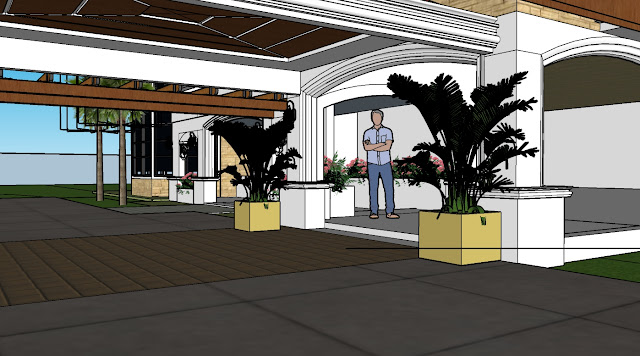The Design Proposal for a Five-Bedroom Residence
In the realm of architecture and design, unveiling a vision, each project is a canvas waiting to be painted with imagination, functionality, and innovation. It is with great enthusiasm that I present the design proposal for a quintessential five-bedroom residence, a harmonious fusion of aesthetics and practicality aimed at creating a haven for modern living.
This Five Bedroom Residence is another undertaking in our design process where the traditional style of architecture is considered. The form and character match the features of Italian Mediterranean architecture. The inclusion of gutters is the adaptation to this style, which is good for tropical countries where heavy rain waters are collected through a downspout running down the drain.
The 3d Modelling in SketchUp is done to visualize the design concept of this Five Bedroom Residence
As we are in the process of identifying the right theme and style for this 5-bedroom residence, The 3d model is a perfect tool to visualize the outcome of the design, as shown in the picture below.
After creating the 3d model, the material texture is done to visualize the outcome of the design if it is achieving the Design goals.
Looking at a different view within helps determine the required design details like the ceiling sections, the selection of doors, and their materials, floor finishes, and wall treatment.
After the 3d model, the architectural style can be more defined with the selection of finishing materials. This is a good opportunity to look into what impression you can make with your design. The color scheme will influence the style generated from the form and shape of the house and the intricacy of details. An example of the Mediterranean style, the architect integrates the level of details that characterize the style in the contemporary setting. Background knowledge of the history of architecture will be beneficial in establishing the overall design concept and the design philosophy.
More of the criteria needed to achieve the Architectural Design Proposal of this Five-Bedroom Residence can be broken down into these categories;
At the heart of this design proposal lies a commitment to seamlessly blend form with function, ensuring that every element serves a purpose while evoking a sense of beauty and tranquility. The overarching concept revolves around creating a space that fosters a connection, with both the surrounding environment and its inhabitants.
The residence layout is meticulously crafted to optimize spatial flow and enhance the living experience. Upon entering the foyer, guests are greeted by an expansive living area that transitions effortlessly into an open-plan kitchen and dining space. Floor-to-ceiling windows flood the interiors with natural light, blurring the boundaries between inside and outside and offering a panoramic of the surrounding landscape.
The five bedrooms, strategically positioned across different levels of the residence, serve as private sanctuaries tailored to meet the diverse needs of the occupants. Each bedroom is thoroughly designed to maximize comfort and functionality, with ample storage space, en-suite bathrooms, and panoramic views of the picturesque surroundings. Natural materials and earthy tones create a warm and inviting atmosphere, relaxation, and rejuvenation.
In celebration of the natural beauty surrounding the residence, outdoor living spaces are seamlessly integrated into the design. A sprawling terrace, complete with a lounge area and al fresco dining space, provides the perfect setting for entertaining guests or simply unwinding amid the tranquility of nature. A lush garden, adorned with native flora and fauna, serves as an oasis of serenity, inviting residents to reconnect with the natural world.
Environmental sustainability lies at the core of the design proposal, with a focus on incorporating eco-friendly features and technologies to minimize the ecological footprint of the residents. From passive design strategies that optimize natural ventilation and daylighting to the integration of renewable energy systems such as solar panels and rainwater harvesting, every aspect of the design is carefully considered promoting sustainability and resilience.
Beyond its role as a private residence, this design proposal envisions the creation of a vibrant community where residents can come together to forge meaningful connections and foster a sense of belonging. Shared amenities such as communal gardens, recreational spaces, and multipurpose facilities encourage social interaction and promote a sense of community cohesion.
In essence, the design proposal for a five-bedroom residence represents a harmonious blend of artistry, functionality, and sustainability, aimed at creating a sanctuary for modern living. It is a testament to the transformative power of architecture and design to shape our lives and elevate our collective experience of home. As the vision begins to take shape, I am excited to embark on this journey of creation and bring this vision to life. In the canvas of architecture, every stroke tells a story.
The narrative unfolds with the design proposal for a five-bedroom residence - a story of beauty, functionality, and the boundless possibilities of imagination.
If you would like to have your own unique house design, you can contact me at arkiventure2@gmail.com.
































